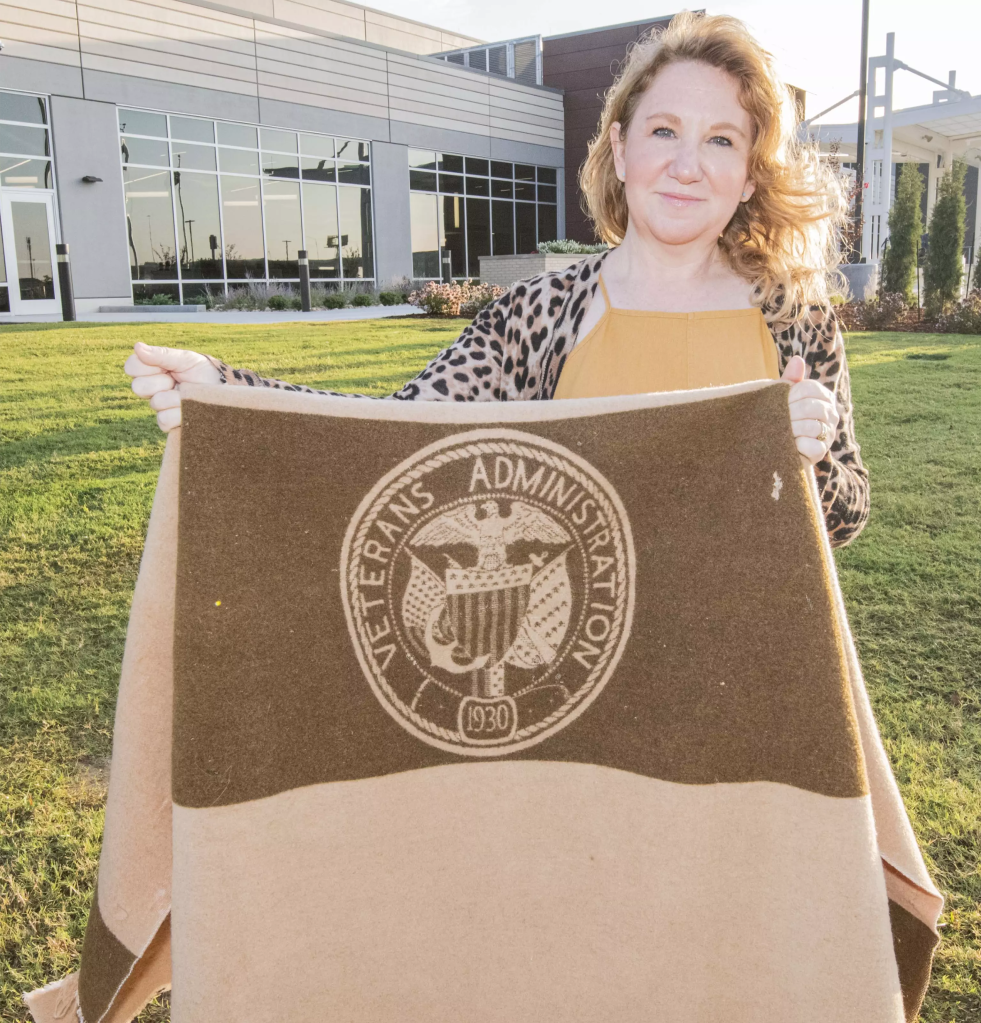
VA has always been a central piece of Dr. Arena Mueller’s life.
In 1987, Mueller’s mother began work as a VA nurse at the Jack C. Montgomery VA Medical Center in Muskogee, Oklahoma and retired from the hospital 23 years later.
“When I was 12 years old, I sang ‘Oh Holy Night’ in the chapel on Christmas Eve,” Mueller said with a laugh. “I kind of feel like I grew up at the VA hospital.”
Following in her mother’s footsteps
In 2009, Mueller decided to follow in her mother’s footsteps and care for Veterans. She’s a psychologist and local recovery coordinator, also at the Jack C. Montgomery VA Medical Center.
Interesting flea market item
In her off-time, Mueller enjoys visiting antique stores. “I love history. I typically make the rounds through various Tulsa flea markets and antique shops.”
About 10 years ago, she noticed a VA emblem on a tan and brown wool blanket while browsing.
“It was folded in such a way that I could see the VA emblem,” Mueller said. “I immediately unfolded it and saw the year 1930 stamped on it. It was only $25 so I scooped it up.”
The blanket spent time in her home and was also used as a decoration in her VA office.
Donating to National VA History Center
Recently, Mueller read about the National VA History Center and decided to contact them.
“I told them about this blanket that I had, and they said they’d be interested in seeing some pictures,” Mueller said. “I sent them some and they responded letting me know that the collections committee voted unanimously to accept my donation.”
While the exact history of the blanket will never be known, it is something to contemplate. Who was the Veteran it warmed in 1930? What happiness, joy, tears, and sorrow did it witness? Did it provide any comfort during difficult times? How, almost 100 years later, did it wind up with a price tag attached?
One important clue might be the state of Oklahoma opened the Soldiers Memorial Hospital in Muskogee in 1923 to care for American doughboys who fought in Europe.
“I do believe this blanket is probably from the Muskogee VA hospital,” said Mueller. “World War I Veterans probably slept under it and were cared for underneath it.”
The National VA History Center will be the museum and archival center for all things historical in the VA mission. It will be on the Dayton VA Medical Center campus – itself a designated National Historic Landmark.
While the idea is not new, recent actions to make it a reality are. Ceremonies marking its official establishment – and the start of renovation work on two historic buildings to house the collection – were held in August 2020. Based on the pace of private fundraising by the Foundation, receipt of grants, or other dedicated funding partnerships, the center’s forecasted opening will be in 2025-26.
This is an article from the Eastern Oklahoma VA Health Care System and provides an example of the role the National VA History Center serves in receiving artifacts into the collection.
By Nate Schaeffer
Public Affairs Specialist, Eastern Oklahoma VA Health Care System
Share this story
Related Stories
Curator Corner
It isn’t often that researchers who work with historic objects get to know the people who used those objects every day. Sometimes we get lucky and can link artifacts to certain facilities or buildings on a historic VA campus, but usually we must look for more hidden lines of evidence to figure out how an object fits into the history of those who care for our Nation’s Veterans. As nice as it would be, it isn’t as if many artifacts turn up labeled with their owners’ names! So, imagine my surprise when my teammates and I began sweeping Putnam Library for any historic objects left behind before the building is closed for renovation, and found just that.
As far as artifacts go, its story seemed simple: book presses like these would have been used to help maintain and repair the thousands of books read in Putnam Library ever since it first opened in 1879. The day that I first got up close and personal with the press, I noticed a woman’s name scraped into the black paint of the platen (the technical name for the big metal plate used to hold books together). It said “Helen Carson” in big, legible letters. As we carefully transported the heavy press down the many stairs inside Putnam Library, I looked at the name and thought “Hm…wonder who that is?”.
Curator Corner
Mary Lowell Putnam is tied to VA history by her generous donation of a large volume of books to the Central Branch of the National Home for Disabled Volunteer Soldiers. These books, meant to honor her son who died in the Civil War, helped foster reading advancement for the Veterans who lived there after the war and into the 20th Century. However, her life was more than just a moment in time donating books. It included a life-long study of languages and a very sharp opinion that she shared in writing throughout her life.
Curator Corner
Presidents George Washington and Abraham Lincoln are among the most easily recognizable figures in American history. Their faces are symbols of wisdom, strength, and leadership. Even today, polls consistently rank them as the greatest or most successful presidents. With that in mind, it is unsurprising that the appreciation of these legendary statesmen has deep historic roots. In honor of their birthdays, our team at the National VA History Center explored those roots through this pair of plaster busts.






